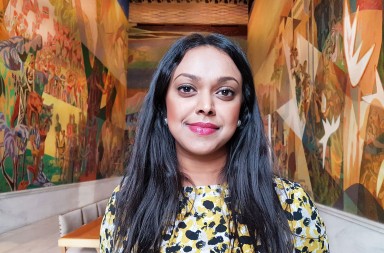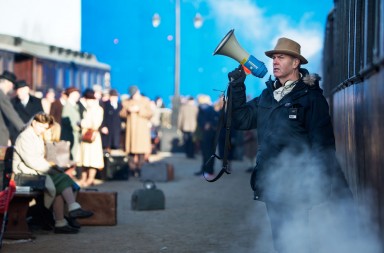The Vigeland Park is one of Norway’s most visited attractions and the world’s largest sculpture park made by one single artist. Discover the artist Gustav Vigeland, and the meaning behind his powerful sculpture park in Oslo. TheOsloBook together with the Oslo Guidebureau invite you to visit this unique place.
Iori Roberts, a professional guide from Oslo Guidebureau about the Vigeland Park:
The Vigeland Sculpture Park
The unique sculpture park is the life work of Gustav Vigeland with more than 200 sculptures in bronze, granite and wrought iron. The park can be divided into 5 main units that are located along the 850-metre-long main axis: The main gate, the bridge with the children’s playground, the fountain, the monolith plateau and the wheel of life. Norway’s most famous boy, the angry boy, is located in the middle of the bridge together with more than 50 bronze sculptures where the artist wanted to display mainly young people and show the relationship between men and women.
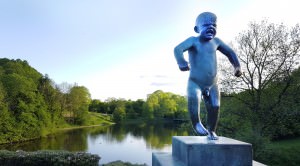
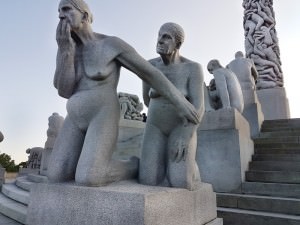
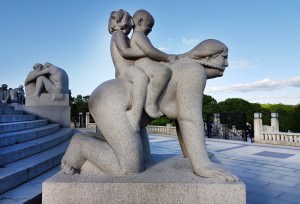
The fountain is surrounded by 20 trees with sculptures that show the four stages of life: childhood, adulthood, parenthood and old people. The last tree contains a skeleton as a symbol of death, and also to show that man becomes nature after he dies. 36 sculptural groups reside on the monolith plateau around the main section of the park: an impressive monolith at almost 18 metres high, carved from one single granite block. It displays 121 figures and might be understood as an interpretation of man’s longing and yearning for the spiritual and divine. The carving of this monolith took over 14 years, and involved work by the artist himself as well as 3 other stone carvers.
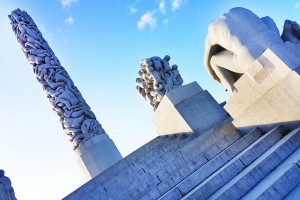
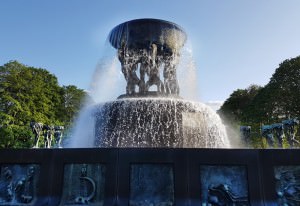
The Wheel of Life, positioned at the very end of the 850-metre axis, continues thematically the journey-of-life motif prevalent in the rest of the park. It represents eternity, with four human figures and a baby locked in a circle, floating in harmony.
Vigeland and Munch: Artistic Rivals
Gustav Vigeland (1869–1943) donated all his works, including his future works, to the city of Oslo. In return, the city gave him the park and a studio that he could live and work in. The studio is the Gustav Vigeland Museum today, where guests can see more of Vigeland’s works and learn about how the park developed throughout time.
It took quite a while to complete the park. They started out in the 1920s, and the park was sadly not completed before Vigeland’s death in 1943. Fortunately, the final result we see today is true to the way Vigeland visualised it.
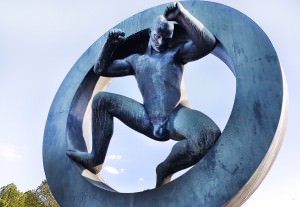
The main theme in the park is the circle of life. This is also the reason why Vigeland displayed all the sculptures, except the one of himself, without clothes. He wanted them to be timeless. Today, we can easily identify with the sculptures that look just like we do today, instead of resembling people from the distant 1920s or 1930s.
Edvard Munch (1863–1944) and Gustav Vigeland lived at the same time, but were rivals rather than friends. As young artists, they both lived in Berlin and even shared the same hotel address at one point. Even though they respected each other as artists, they were never close. Munch even accused Vigeland of stealing his main idea: While Vigeland devoted his park to the circle of life, Munch’s main project was the frieze of life.
The Echo Point near the Monolith
The ground around the fountain is surrounded by an 1800 square metre mosaic in black and white granite. The geometrical pattern shapes an almost 3000-metre-long labyrinth. Vigeland’s intention was to show all the blind alleys and difficult roads human beings have to go through in their lives. Perhaps Vigeland also wanted to let us know the following: “You can find the right way out of life’s labyrinth with patience.”
Iori Roberts, a professional guide from Oslo Guidebureau about the echo:
How to get to Vigeland Park:
The Vigeland park is part of the even larger Frogner park, and can easily be reached with buses, trams and the metro.
Tram stop: Vigelands park, takes you directly there.
Bus stop: Vigelands park.
Metro stop: Majorstuen, with just a 10-minute walk down Kirkeveien.
If you wish to learn more about Oslo, book a professional guide at Oslo Guidebureau:
Phone: +4722422818 / Mail: info@osloguide.no

Text: Stefanie Tuma / Photos&Videos: Dina Johnsen
